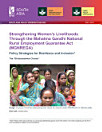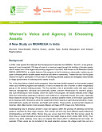Cluster-based development: Lessons from country experiences for Odisha, India
Belton, Ben · Breisinger, Clemens · Kassim, Yumna · Pal, Barun Deb · Narayanan, Sudha · Zhang, Xiaobo
Apr 2025 · South Asia Policy Perspectives Book 1 · Intl Food Policy Res Inst
Ebook
5
Pages
family_home
Eligible
info
reportRatings and reviews aren’t verified Learn More
About this ebook
Clusters are spatial aggregations of small businesses producing the same or related goods or services. Together, these businesses have the potential to contribute to economic development of rural areas by compounding the existing strengths of local producing communities. Cluster-based development has been successful where governments facilitate infrastructure and provide services to support existing clusters, often leading to spillover and expansion of these clusters to wider areas over time (Abdelaziz et al. 2021). Agrifood cluster development can occur via two broad mechanisms: (1) immanent development, where clusters of commercial farms as well as firms in the value chain that provide goods and services re quired by farms (for example, specialized production inputs, machinery, and transport), emerge spontaneously in co-located groups; and (2) organized development, where actors such as government, companies, or nongovernmental organizations (NGOs) organize producers into groups to deliver extension services, inputs, or credit or to upgrade production practices, facilitate collective action to improve terms of market access, or enable compliance with standards or forms of branding such as geographic indications.
Rate this ebook
Tell us what you think.
Reading information
Smartphones and tablets
Install the Google Play Books app for Android and iPad/iPhone. It syncs automatically with your account and allows you to read online or offline wherever you are.
Laptops and computers
You can listen to audiobooks purchased on Google Play using your computer's web browser.
eReaders and other devices
To read on e-ink devices like Kobo eReaders, you'll need to download a file and transfer it to your device. Follow the detailed Help Center instructions to transfer the files to supported eReaders.




